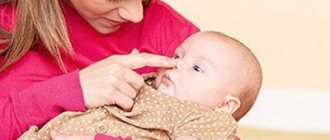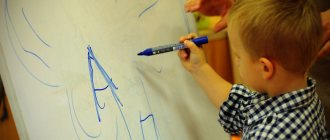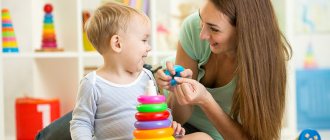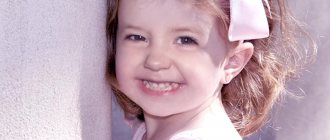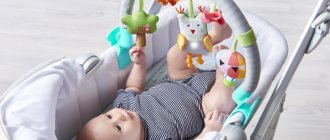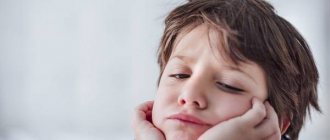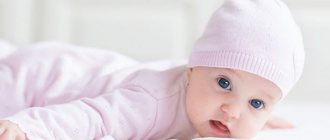Article on the topic
Children weighing up to 500 grams are not nursed?
Our expert is an audiologist at clinic No. 3 of the UDP of the Russian Federation Andrey Izosimov .
This story is real. On September 1, in one of the regular Moscow schools, the teacher, before starting the lesson, asked the students to listen to the mother of their classmate. Mom showed the kids a small object: “This is my son’s hearing aid. Without it he can't hear. You can carefully examine it, and I will tell you how it works.” The guys have a genuine interest in this curiosity. And even respect for its owner. The boy is no longer ashamed of his illness. He, who had recently been doomed to isolation, now had the opportunity to communicate with his peers on equal terms. And all because the mother realized in time that her son had problems with his hearing, and did everything to return the child to the world of sounds.
From the first days
Here they are - the long-awaited first words that the baby says: “Mom, dad, lala...”. One toddler quickly masters the wisdom of communication, while another child finds the world of words more difficult. And one in a thousand newborns stubbornly remains silent, and adults sometimes have no idea that the reason for this is the hearing impairment with which the child was born. If parents do not take decisive measures from the first months of the baby’s life, then the child will never hear human speech, which means he will not learn to speak.
How to suspect in time that your baby has hearing problems?
There are many reasons for hearing loss. The baby may have difficulty hearing:
● if he was born prematurely and/or weighed less than 1.5 kg at birth;
● if immediately after birth the child was unable to breathe on his own or received an intracranial injury during childbirth;
● if during pregnancy the mother suffered a dangerous infection (rubella, influenza, herpes, cytomegalovirus, toxoplasmosis);
● if the mother was treated with ototoxic drugs (some antibiotics, diuretics) during pregnancy;
● if hearing loss is a hereditary disease in the family;
● for genetic disorders.
Professional hearing test
Children's hearing is regularly checked by medical commissions at the children's clinic. The first of them takes place in 2-3 months. The choice of hearing testing technique by a specialist will depend on the equipment of his office with the necessary instruments, as well as on the age of the patient.
- For newborns and infants, the hearing threshold is determined using computer audiometry. Testing children's hearing using a device is the most reliable modern method. An audiogram allows not only to identify the fact of a disorder, but also to determine in which part of the hearing organ the disorder occurred and what is the degree of hearing loss in the baby. Special sensors record the response of hair cells in the cochlea and the electrical activity of the brain to the signals supplied by the device.
- Behavioral audiometry is recommended for children from six months of age. The specialist evaluates how the child reacts to sounds of different intensities and tones, and based on this testing, determines the baby’s hearing threshold.
- To test the hearing of children from 3 to 5 years old, the method of play audiometry is used.
- For school-aged children, hearing acuity is tested using speech audiometry, during which children are asked to repeat whispered words and phrases. If necessary, tuning fork testing is used.
What to pay attention to
How to test a baby's hearing? Doctors have not yet learned how to determine whether a child can hear in the womb. But methods exist that make it possible to accurately tell almost immediately after birth whether the baby can hear. In Scandinavia, for example, all newborns are screened for hearing loss by recording otoacoustic emissions. This is an objective diagnostic method, so it can be used to study hearing even in the smallest children. Unfortunately, our country does not yet have the practice of testing hearing of all newborns. Therefore, parents themselves need to be attentive and watch the baby:
● Does the baby flinch from loud noises in the first 2–3 weeks of life?
● Does he or she “freeze” when hearing adult voices at 2–3 weeks of age?
● Does the head turn towards the mother’s voice at the age of 1–3 months, and at the age of 4 months – towards the sounding toy?
● Does the child at one and a half to six months react by screaming or opening his eyes wide to sharp sounds?
● Does he hum at two to four months? Does this humming turn into babbling by 4-5 months?
● Does he develop new (emotional) babbling when his parents arrive?
● Does the baby develop any new sounds at 8–10 months?
If, after such observations, parents are alarmed by something, they should show the baby to the doctor.
Hearing Test Methods
How is hearing tested in newborns? The first time a child’s ability to hear is determined in the maternity hospital. Audiometry is done using a special device that delivers different-frequency sound signals directly into the ear and records the response of the internal organ to them. During the study, the audiologist is able to determine in which parts pathological changes occur that affect the child’s ability to perceive the noise around him.
But the first audiometry helps diagnose only severe forms of hearing loss, while initial deviations from the norm at such early stages cannot be determined by a hearing test. That is why parents should be concerned with the question of how to test a newborn’s hearing at home, and regularly conduct testing using specially developed methods.
Moro reflex
One of the methods available for testing a newborn's hearing is based on the Moro reflex. This diagnosis can be easily carried out by parents at home. It will not help you determine what the infant’s hearing threshold is or assess the degree of sensitivity of the auditory receptors, but this technique can eliminate severe grade 3 and 4 hearing loss.
- The newborn should be placed on a flat surface and his limbs should be straightened as much as possible. There is no need to do this forcefully - try smoothing the arms and legs along the outer surface.
- At a distance of about 20 cm from the baby's ear being tested, clap your hands loudly. In response to a sharp sound, the child must respond adequately - cry, flinch, or spread his fingers.
- In the same way, the newborn's second ear should be checked for low-frequency sensitivity.
Consequence of diseases
If in doubt, consult a specialist with an older child - he, too, is in for trouble: hearing can be affected by illness (meningitis, encephalitis, severe forms of measles and mumps), frequent otitis media (and inflammation of the middle ear sometimes occurs without noticeable symptoms), from medications, giving complications to the ears, from traumatic brain injuries.
Technological progress also makes its contribution, testing our ears with exorbitant loads. Sensitive auditory cells in the inner ear die from excessively loud and prolonged sounds. The roar of the street alone, which does not stop day or night, is almost 90 decibels. What can we say about the deafening roar of a jet plane (120 decibels), the subway, or a rock concert? The ears are begging for mercy. But we don’t hear their pleas and add music flowing from the headphones of the ubiquitous player...
A survey conducted in the Moscow region revealed hearing loss in more than half of repeat year students! Children turned into laggards simply because they were not examined on time.
Hearing test at home
Unfortunately, hearing problems are not only congenital. Infectious diseases, injuries, etc., suffered by the baby, can negatively affect the functionality of the hearing organ.
If you suspect a deterioration in your baby's ability to hear, you should make an appointment with a doctor, but in order not to waste a specialist's time, you can try to test the child's hearing and its acuity at home.
How you can test your child's hearing acuity at home will depend on the child's age.
Newborn
It is almost impossible to conduct an objective hearing test of a newborn at home. In the first month of life, a baby’s ears do not function the same as those of adults, and in general, he is not yet able to show reactions to audible sounds.
Perhaps the most accessible and effective method that you can use at home to test your newborn’s ability to hear is clapping. If you clap your hands loudly out of sight of a child, in response to a sharp sound he should react reflexively - shudder or throw up his whole body.
Baby
In children of the first year of life, hearing can be tested using cereals. Pour peas, buckwheat and semolina into plastic containers. These three types of cereals, when shaken, create sound vibrations of varying intensity and tonality.
This technique should be used in stages, as the functionality of the infant’s hearing organs gradually increases with age. At first, the baby is able to hear mainly low-pitched sounds - such as those created by shaking a jar filled with peas.
An adult should shake the container with peas so that the baby does not see it. The baby must react to the sound he hears - freeze, frown, flinch or jump up. By 3-4 months, the child should be able to turn his head in the direction where the noise produced by the cereal comes from.
Cartoon model
As soon as the doctor has diagnosed hearing damage and admitted that neither treatment nor surgery will solve the problem (and in 90% of cases, alas, this is exactly the case), you should immediately contact a hearing prosthetist. He will select a high-quality hearing aid for your child and adjust it precisely in accordance with the individual characteristics of hearing loss. Only then will a child with hearing problems be able to hear, learn to speak, develop normally, and then be able to study in a regular school. But hurry: your child should be fitted with hearing aids as early as possible, immediately after the diagnosis is made (ideally before six months of age).
The most favorable period for language acquisition is from 7–12 months to 3.5–4 years. The later, the worse the result, the more efforts of parents and teachers of the deaf will be required for the child to master speech. If hearing correction is delayed until the age of five, teaching a child to speak coherently will be almost impossible.
Of course, the baby needs a special device: as durable and light as possible, invisible to others, so that the child does not feel embarrassed to wear it. Or, on the contrary, bright, colorful, decorated with cartoon characters, so that it becomes the envy of peers. These are the models offered to children by companies specializing in the production of modern digital technology. Experts have their own requirements for a hearing device: it must be powerful, have a wide frequency range, and display sound as accurately as possible. After all, the better the device, the faster and better the child will learn to hear and speak, the brighter and more full-bodied his life will be.
How can you tell if your child can't hear?
If a child does not respond to requests and does not turn in your direction when you call him by name, then this is not always a simple prank. Perhaps this is his way of showing his character and testing your patience. But in most cases, such a behavioral reaction indicates hearing impairment.
At an early age, namely up to 1 year, insufficient hearing for children is considered normal. In a one-year-old child, the auditory analyzers become more advanced, so the baby already hears a sufficient number of sounds.
When should hearing loss be considered a problem? First of all, you need to pay attention to the child’s reaction to too loud stimuli. For example, various objects falling from a height onto the floor.
If the baby does not react to such a situation, then during the observation process you can find that the child does not perform the following actions:
- does not respond to your voice;
- upon reaching 4 months does not respond to the speech of strangers;
- by 4 months does not turn his head towards the source of music;
- by 6 months does not make any sounds;
- by the 1st year does not respond to requests;
- by the age of 2 he does not speak.
Due to severe hearing disorders, the baby may behave as follows:
- communicates little with others;
- aggressive;
- constantly asks questions during conversations;
- monitors the facial expression and movement of the interlocutor’s lips;
- does not hear the speaker behind him;
- constantly increases the volume when watching television programs;
- has difficulty hearing speech during telephone conversations.
If a child touches his ears regularly, his ears may be infected or have high pressure.
If such symptoms are detected in a child, you should contact an otolaryngologist for advice. Only an experienced specialist will be able to determine the exact causes of hearing disorders. Based on the results of the examination, the doctor will prescribe treatment or recommend wearing a hearing aid.
It is important to remember that the easiest way to test your hearing is by responding to your speech and musical toys. If there is no corresponding reaction, it is recommended to monitor the baby during sleep. As soon as the baby falls asleep, use any toy with a squeak and watch the baby's reaction. Squeeze and unclench it several times near each ear so that the air is not directed towards the baby’s face. If there are no problems with hearing, then breathing will become deeper and noisier. The baby may express his concern and even open his eyes. After simple steps, we can conclude that he hears well.
Children's hearing can also be tested while they are awake, when the child is in a good mood and actively playing. Stand behind him and turn on a musical toy or use a bell. At this moment, it is necessary that the child does not notice your presence from behind with his eyes.
Every parent should know that it is possible to prevent possible complications from hearing analyzers only by systematically visiting an ENT doctor. Timely detection of pathology and its effective treatment will save the child from hearing problems in the future.
